Anselm Kiefer at the Royal Academy of Arts, Piccadilly, London.
I can't remember the last time I went to an exhibition and did not want to leave. This exhibition is a total experience, one that draws you in.
Kiefer creates contemporary history paintings in the grandest possible fashion. His themes include the Holocaust, Egyptian mythology, German mysticism and the poems of Paul Celan, a Holocaust survivor who wrote some of his poems in the concentration camp where he was incarcerated. Ash, sand, gold leaf, broken ceramics, diamonds, straw, and wood are some of the materials Kiefer uses. Bark-like layers of pigment and shellac protrude from the canvas like relief sculpture. A lot of Kiefer's paintings are monochromatic with impasto surfaces to which organic matter, including sunflower stalks and bundles of straw as well as metal objects such as books made out of lead are included. He sometimes leaves his paintings out in the wind and the rain, or bathes them in acid in order to achieve their battered, time-worn surfaces.
This is an exhibition which is foremost about memory. Kiefer has resurrected the horrors of the 20th century in a shocking and explicit way and is determined not to allow us to forget. History is at the centre of this exhibition and even though parts of it are very beautiful, there is horror there too. Ash is one of the predominant materials that has been used - ash reminiscent of the nightmare of the Holocaust, not just the ash of bricks and mortar but also the ash of human flesh. Death ash. You cannot escape it.
Looking at the top of the gallery's stairs, the shop has disappeared and in its stead a monumental sculpture consisting of a pile of charred-looking books with a huge set of wings attached. The phoenix rising out of the charred remains of our civilisation?
Language of the Birds, 2013
Room 1:
There are some early paintings and drawings in this room and various vitrines containing several books Kiefer has created. Books have been central to Kiefer's practice since 1968. He considers them works in their own right but also intimate visual diaries in which he seeks to 're-create a memory'.
Finding that his history lessons at school only touched lightly on the Third Reich, he was drawn to address this collective absence of memory, and created his 'provocation' in the painting series Heroic Symbols and the Occupations books. In these he used his own body, dressed in his father's German army uniform, to confront the viewer with the realities of Germany's history.

Heroic Symbol V, 1970
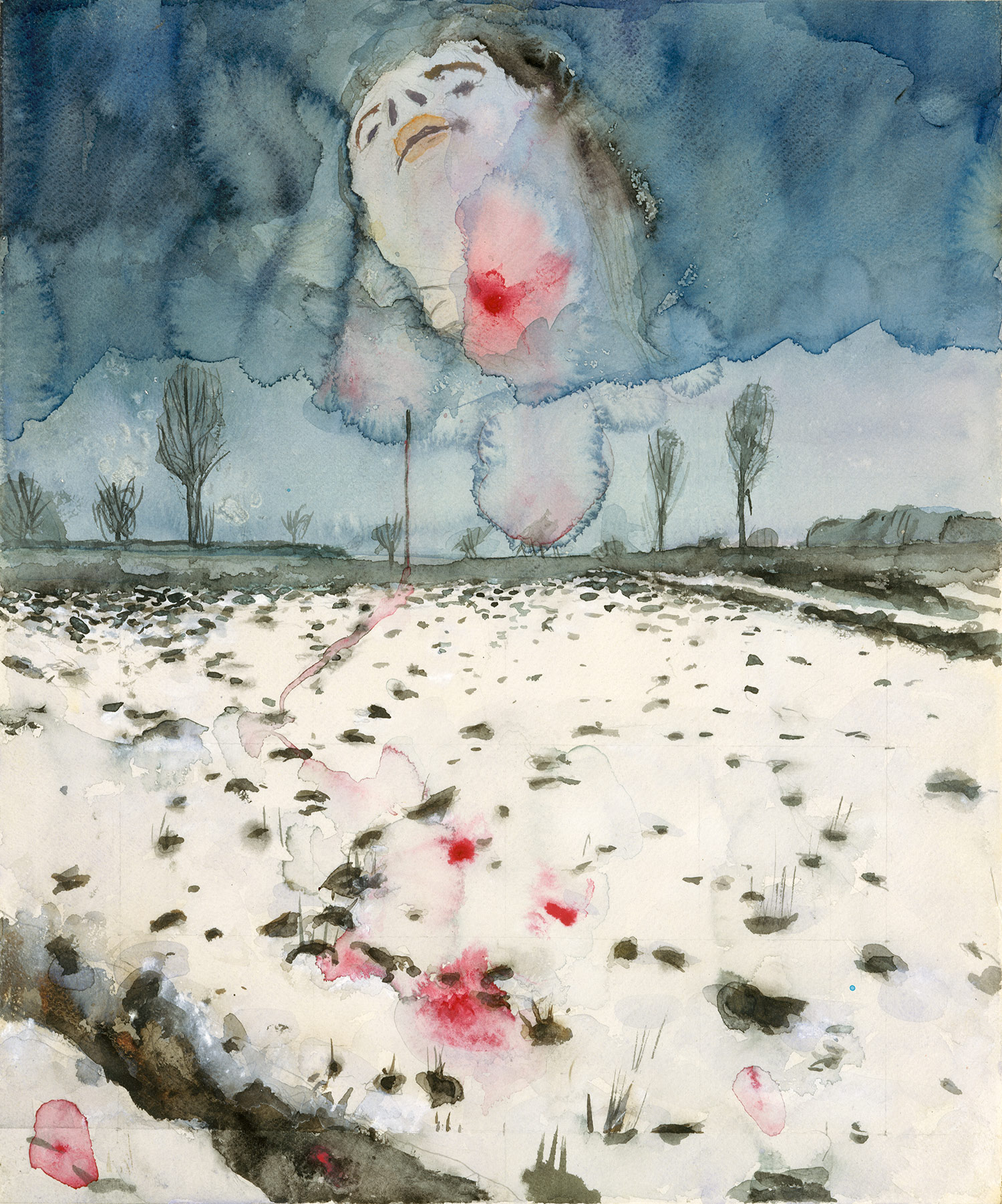
Winter Landscape, 1970
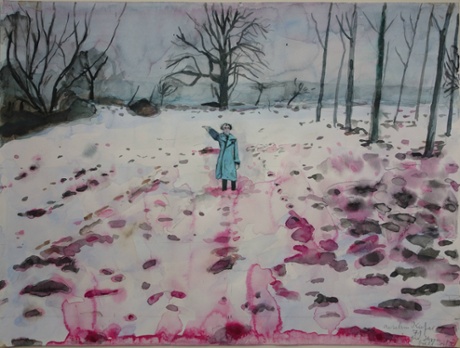
Ice and Blood, 1971
The expanse of snow is scarred with pools of blood - a tiny figure in a military overcoat has its right arm ominously raised.
Room 2 - The 'Attic' Paintings:
Parsifal I, II, III
These were made between 1971 and 1973 and they depict Kiefer's studio of the time. Here he re-created mythological, religious and historical events.
Parsifal I
Parsifal II
Parsifal III
Nothung
This refers to the sword in the Nibelung myths and Richard Wagner's Ring cycle.
Father, Son and Holy Ghost
The Holy Trinity is represented by the three chairs which are surmounted with heavenly flames, cleansing and purifying. Fire is a powerful symbol for Kiefer, one that mediates between Heaven and Earth. The flames also lick at the staircase that ascends to the painter's studio, the furnace of creativity.
Room 3:
This room is about the landscape of German history and the buildings of the Third Reich. Albert Speer and Wilhelm Kreis were commissioned by the Nazis to design buildings to exalt the ideology of National Socialism. Kiefer explores the cultural significance of these neoclassical buildings which appropriate the values of ancient civilisations.
Ashflower, 1983-97
A seven-metre depiction of a ruin, a relic of Hitler's empire. Ash has been scattered all over the painting creating a vast, obscuring veil. Dangling in the middle of the painting is a massive dried sunflower.
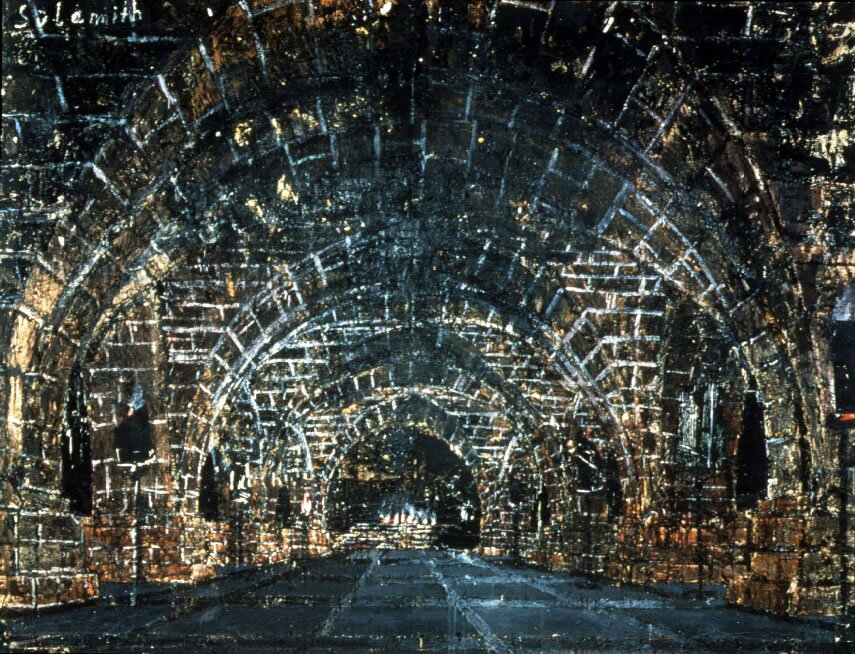
Sulamith, 1983
This was inspired by Paul Celan's poem Death Fugue which was written in a concentration camp. A gloomy crypt at the end of which a fire endlessly flickers
.jpg)
Interior, 1981
Room 4:
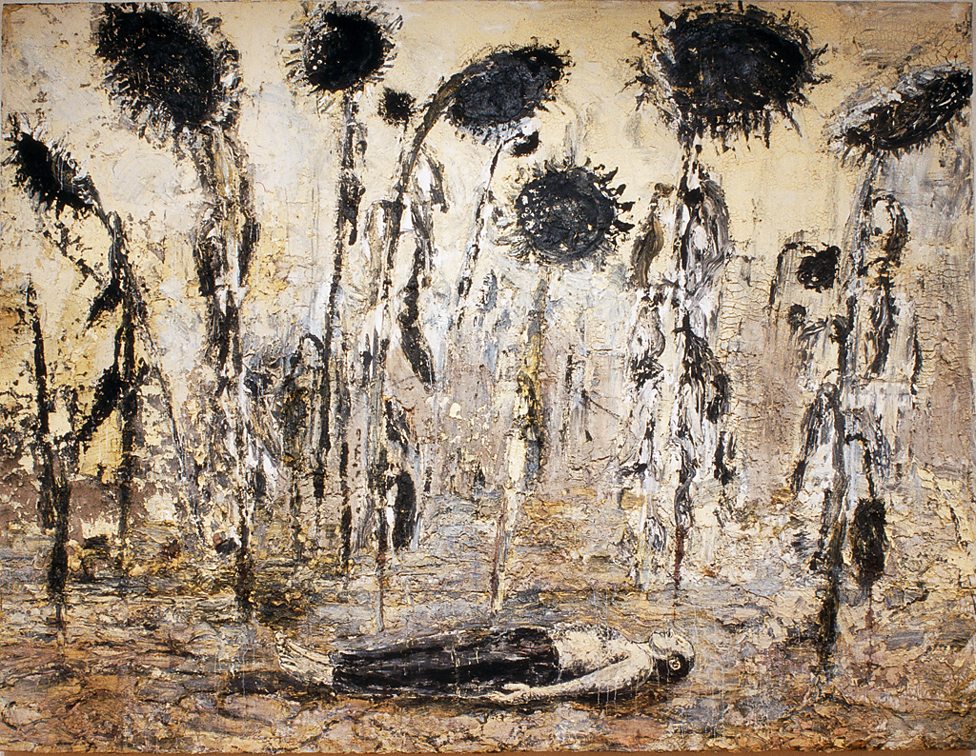
The Orders of the Night, 1996
Kiefer himself lies beneath the sunflowers. Sunflowers follow the sun embodying the connection between the earthy and the celestial and they appear frequently in Kiefer's work. He has said: 'When I look at ripe, heavy sunflowers, bending to the ground with blackened seeds ... I see the firmament and the stars'.
Room 5:
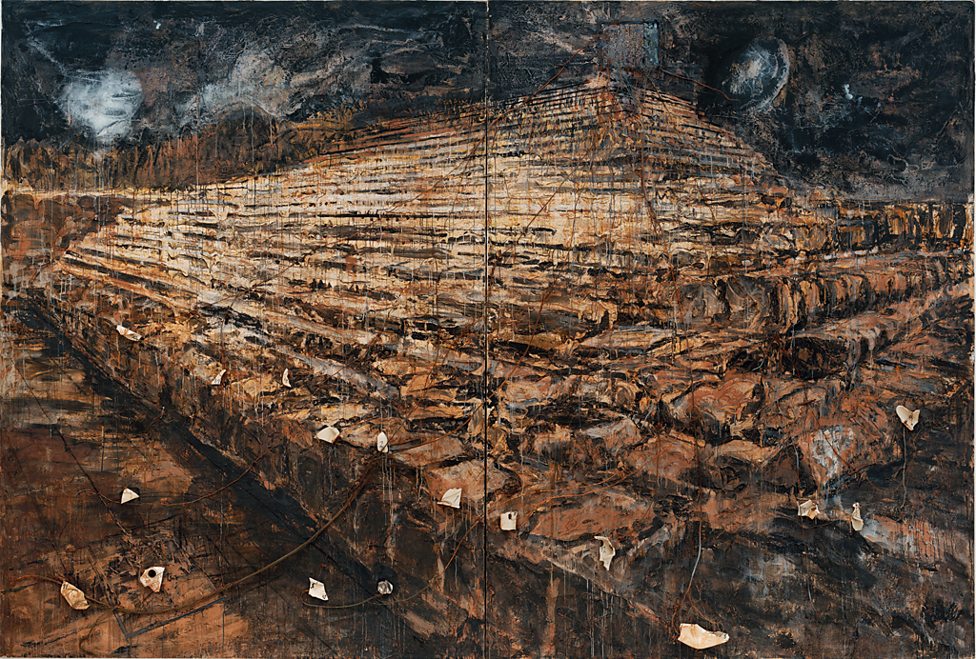
Osiris and Isis, 1985-87
The story of Osiris and Isis is one of death and resurrection. Osiris, god of the underworld, was murdered by his brother Set, who dispersed the dismembered body across the land. Osiris' grieving widow, Isis, searched for his remains, literally 're-membering' and resurrecting him.
Room 6:
Untitled 2006-08 (the blue is reflection from my camera)
Sculpture containers or picture frames? Kiefer's vitrine installations are both. This massive glass-fronted triptych is filled with silvery, thorny branches, concrete, dead roses, ash, toppling houses that evoke a graveyard or a fairy tale.
looking closer.
Room 7:
Ages of the World
A mountain of discarded paintings, piled high. Between each layer of canvases bits of earth and sunflowers sprawl. This installation refers to the history of our planet's evolution, the Romantic aspiration of art, the poetry of ruins, and the relationship between the human individual and the deep time of the cosmos. It touches on the great events of our planet, from the devastating impact of meteorites to the creation of fossil fuels, and hints at an ongoing pattern that will continue - Kiefer's belief in the cyclical nature of time.
Room 8:

Black Flakes, 2006
Lead figures prominently in these two paintings, as Kiefer regards lead as an important material: 'it is in flux. It's changeable and has potential to achieve a higher state of gold'.
Ash Flower, (for Paul Celan), 2006
Here is the rubble and detritus of a wrecked world: the snowy, barren landscapes are referenced by Paul Celan's poems. Snow and ice in Celan's poems refer to the landscape of the Holocaust and symbolise the oblivion and silence that descended over Europe at the time.
Room 9:
The Secret Life for Plants for Robert Fludd, 1987-2014
Stalks of the Night (for Paul Celan), 1998-2013
Sheets of lead. Stars are represented by diamonds set into the material. Kiefer himself appears here. The silver arc over his body suggests that we are at the centre of our own individual worlds, each with our own perceptions and understanding of that unique context.
For Ingeborg Beckmann: The renowned Orders of the Night, 1987-2014
Room 10:
The exhibition featured quite a few books that Kiefer has made. They are powerful symbols for Kiefer, both as a primary source of knowledge, and as repositories of history and world religions. His books are visual, and rarely text-based: 'You do not have to read my books. You only need to scan. I am not picturing words'.
Room 11:
This was my favourite room. The monochromatic palette has been left behind, and a note of hope can be glimpsed. In this room the 'Morgenthau' series of paintings are to be found, referring to the 1944 plan proposed by the US Treasury Secretary, Henry Morgenthau, to transform Germany into a pre-industrial agricultural nation in order to limit her ability to wage future wars.
Within the tradition of landscape painting we see Kiefer's associations with the 19th century painter Casper David Friedrich and with notions of the sublime in nature, whose grandeur inspires awe and wonder. The overriding reference however, is to Vincent Van Gogh, whose late paintings of wheat fields are echoed here with their black crows, symbolising death and resurrection, hovering menacingly above.

The Morgenthau Plan, 2013
The Morgenthau Plan, 2013

The Morgenthau Plan, 2013
Room 12
In this final gallery Kiefer returns to the woodcut and the Rhine of his homeland. We walk through a 'forest' whose format echoes the pages of a book.
A collage of black and white woodcuts, arranged as interlocking screens.
* * *
But, there is more. I have left the two vitrine installations at the entrance last, because they make more sense seen at the end, after the main exhibition.
Velimir Khlebnokov: Fates of Nations: The New theory of War.
Suspended ships and text, related to the work of Russian poet and futurist who believed that great battles at sea occur in a cycle of 317 years, or in multiples of that number.
The models of the submarines float in a 'seabed' that is as dry as dust, a memorial erected by the losing rather than the victor.
This exhibition has to be seen and experienced. Photographs and reproductions will not do.
Sources:
VA gallery guide
http://www.theguardian.com/artanddesign/2014/sep/28/anselm-kiefer-royal-academy-review-rembembrance-amid-the-ruins
http://www.theguardian.com/artanddesign/2014/sep/22/anselm-kiefer-royal-academy-of-arts-review
http://www.theguardian.com/artanddesign/2014/apr/01/anselm-kiefer-royal-academy-of-arts






























This is one I've been looking forward to since I heard that it was coming to the RA.
ReplyDeleteOlga, I could have said that I hope I did not spoil it for you by posting so much about it, but there is no need and no fear. Seeing the paintings for real is so different from seeing photographs, and the experience is so total, that I am sure it will feel like new.
DeleteI look forward to seeing your post about the exhibition.